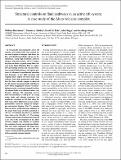Files in this item
Structural controls on fluid pathways in an active rift system : a case study of the Aluto volcanic complex
Item metadata
| dc.contributor.author | Hutchison, William | |
| dc.contributor.author | Mather, Tamsin A. | |
| dc.contributor.author | Pyle, David M. | |
| dc.contributor.author | Biggs, Juliet | |
| dc.contributor.author | Yirgu, Gezahegn | |
| dc.date.accessioned | 2017-10-25T12:30:12Z | |
| dc.date.available | 2017-10-25T12:30:12Z | |
| dc.date.issued | 2015-06-01 | |
| dc.identifier | 245804207 | |
| dc.identifier | c8077b46-75f8-4e35-b577-2b98a1648e60 | |
| dc.identifier | 000359479400002 | |
| dc.identifier | 84936126839 | |
| dc.identifier.citation | Hutchison , W , Mather , T A , Pyle , D M , Biggs , J & Yirgu , G 2015 , ' Structural controls on fluid pathways in an active rift system : a case study of the Aluto volcanic complex ' , Geosphere , vol. 11 , no. 3 , pp. 542-562 . https://doi.org/10.1130/GES01119.1 | en |
| dc.identifier.issn | 1553-040X | |
| dc.identifier.uri | https://hdl.handle.net/10023/11918 | |
| dc.description | Hutchison was funded by NERC studentship NE/J5000045/1. | en |
| dc.description.abstract | In volcanically and seismically active rift systems, preexisting faults may control the rise and eruption of magma, and direct the flow of hydrothermal fluids and gas in the subsurface. Using high-resolution airborne imagery, field observations, and CO2 degassing data on Aluto, a typical young silicic volcano in the Main Ethiopian Rift, we explore how preexisting tectonic and volcanic structures control fluid pathways and spatial patterns of volcanism, hydrothermal alteration and degassing. A new light detection and ranging (lidar) digital elevation model and evidence from deep geothermal wells show that the Aluto volcanic complex is dissected by rift-related extensional faults with throws of 50-100 m. Mapping of volcanic vent distributions reveals a structural control by either rift-aligned faults or an elliptical caldera ring fracture. Soil-gas CO2 degassing surveys show elevated fluxes (>>100 g m-2 d-1) along major faults and volcanic structures, but significant variations in CO2 flux along the fault zones reflect differences in near-surface permeability caused by changes in topography and surface lithology. The CO2 emission from an active geothermal area adjacent to the major fault scarp of Aluto amounted to similar to 60 t d-1; we estimate the total CO2 emission from Aluto to be 250-500 t d-1. Preexisting volcanic and tectonic structures have played a key role in the development of the Aluto volcanic complex and continue to facilitate the expulsion of gases and geothermal fluids. This case study emphasizes the importance of structural mapping on active rift volcanoes to understand the geothermal field as well as potential volcanic hazards. | |
| dc.format.extent | 21 | |
| dc.format.extent | 3547533 | |
| dc.language.iso | eng | |
| dc.relation.ispartof | Geosphere | en |
| dc.subject | Main-Ethiopian-rift | en |
| dc.subject | Langano geothermal-field | en |
| dc.subject | Carbon-dioxide emissions | en |
| dc.subject | Point-like features | en |
| dc.subject | Soil CO2 flux | en |
| dc.subject | Diffuse emission | en |
| dc.subject | New Zealand | en |
| dc.subject | Mt. Etna | en |
| dc.subject | Hydrothermal alteration | en |
| dc.subject | Volatile emissions | en |
| dc.subject | GE Environmental Sciences | en |
| dc.subject | DAS | en |
| dc.subject.lcc | GE | en |
| dc.title | Structural controls on fluid pathways in an active rift system : a case study of the Aluto volcanic complex | en |
| dc.type | Journal article | en |
| dc.contributor.institution | University of St Andrews. Earth and Environmental Sciences | en |
| dc.contributor.institution | University of St Andrews. School of Earth & Environmental Sciences | en |
| dc.identifier.doi | 10.1130/GES01119.1 | |
| dc.description.status | Peer reviewed | en |
This item appears in the following Collection(s)
Items in the St Andrews Research Repository are protected by copyright, with all rights reserved, unless otherwise indicated.

